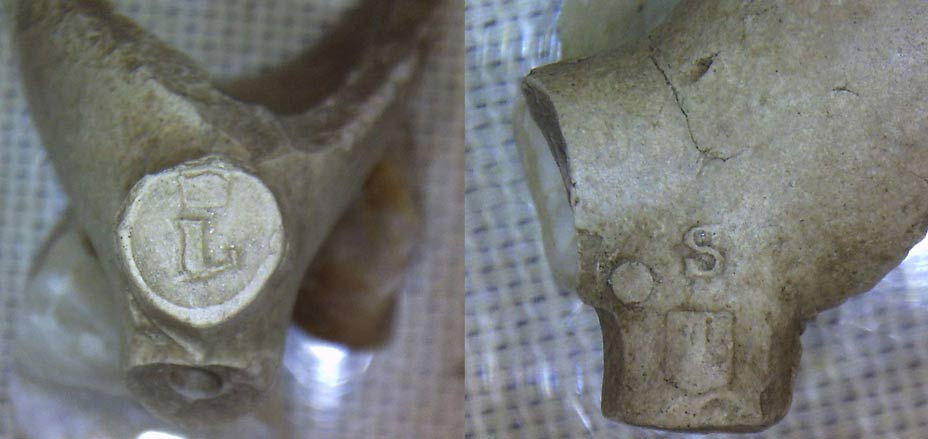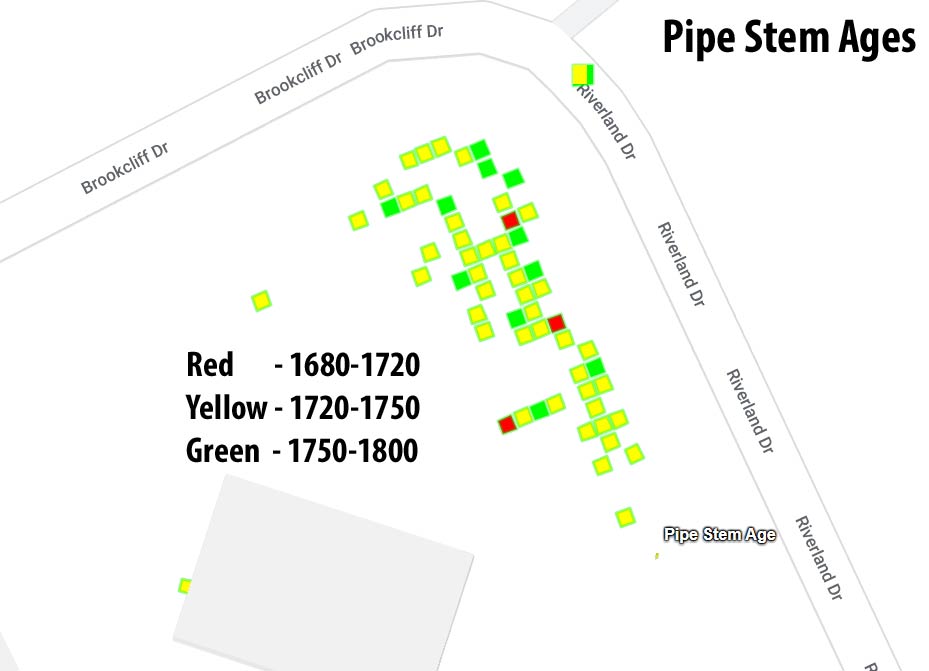Granby Dig Pipe Stems

We love the pipe stems but those
date ranges we have been referring to (in bold below) are a
simplification of a large data set (maybe made up of tens of thousands
of pipe stem finds). It turns out that pipe stems were gradually made
longer over time. To keep strength in the stem, the stem's bore hole
was also made smaller over time thus allowing us, today, to estimate
the age of a pipe stem based on this bore measurement. Unfortunately,
it's not a perfect measurement-to-date formula. This makes it
controversial but, if you look at the original data and your own
collection sample, it can tell you a lot. In our case, we only have 3
sizes and that really lets you narrow it down.
The following is based on the first 53 non-split pipe stems that were found in the Granby dig.
Here's the original data from the Harrington histograms (Harrington
1954-64):
6/64" bore hole (1 of our 25 stems are this size). The simplified range is
1680-1720. Here are the facts:
100% of these were made between 1650-1750.
69% of these were made between 1680-1710
17% of these were made between 1650-1680
14% of these were made between 1710-1750
5/64" bore hole (22 of our 25 stems are this size). The simplified range is
1720-1750. Here are the facts:
100% of these were made between 1680-1800.69% of these were made between 1710-1750
19% of these were made between 1750-1800
12% of these were made between 1680-1710
4/64" bore hole (2 of our 25 stems are this size). The simplified range is
1750-1800. Here are the facts:
100% of these were made between 1710-1800.
86% of these were made between 1750-1800
14% of these were made between 1710-1750
86% of these were made between 1750-1800
14% of these were made between 1710-1750
80% of our pipe stems have the 5/64" bore hole which is generalized to the date range 1720-1750. The town of Granby did not form until after the death of Indian Trader Thomas Brown in 1747. Brown's Congaree River land went from about 200 feet North of the Granby dig site to 600 feet south of the dig site. So, Thomas Brown may have lived on our Granby site and, in fact, we have found two early 18th century Jews Harps which were Brown's top item of trade. With one of the harps was a 5/64" pipe stem.
We got a major break in pit 85 with the discovery of a large piece of a pipe bowl and stem (see picture below). Maker marks on the item date it to 1740 to 1760. The pipe stem on this was also 5/64" so that generalizes the range to something more like 1740 to 1750. When Brown died in 1747, his land was, eventually, acquired by Martin Friday who started his Ferry at that northern boundary of Brown's property. It probably took a few years for Granby to start forming so it's probably safe to assume that these 5/64" pipe stems came from Thomas Brown. The post holes we have found in the dig may be from a structure of Brown's because the Johnston house (which we have found in the dig) was built in 1790 when Granby buildings had brick foundations and not posts. This can be seen in the only surviving Granby building (also built in 1790) at the Lexington County Museum.
The Johnston family lived in Granby from 1791 to 1815. Since we know that none of the pipes can be from after 1800, it seems that the Johnston family were not pipe smokers.
The 16% of pipes we have found from the generalized period of 1750 to 1800, are then probably from the time after Brown's death and when the Johnston family came in 1791.
The bottom line is that, thanks to these pipe finds, we now know that our dig site is on top of Brown's site (1730-1747) and the Johnston home site (1791-1815).
An interesting side-note: We have found 5 bowl base and stems after 96 pits. Pipe stems pieces are about 1 inch in length which is about the minimum length human fingers can snap off. If you do the math, 96 pipe stems found in 96 pits and 5 bowl bases found, that would make the length of each pipe, about 18 inches long. Pipes from that period had an average length of 16 inches.
Below are images of the maker marks (on that Pit 85 pipe we found) that help us get a good date on the pipe.

Our Pipe Stems (click on a link to see a picture of the particular pipe stem):
Pit Level Count Date
3 3 1 1720-1750
5 3 1 1720-1750
6 3 1 1720-1750 : Decorated
9 3 1 1720-1750
13 3 1 1720-1750
14 3 2 1720-1750 : Base of bowl with a heel
17 2 1 1720-1750 : Unusual brown color
17 3 2 1720-1750
18 3 1 1720-1750 : Long stem piece
21 2 1 1720-1750
21 3 1 1720-1750
22 3 1 1720-1750 : Painted and burned
24 3 1 1680-1720 : Long stem piece
24 3 1 1720-1750
26 2 1 1720-1750
27 3 1 1720-1750 : Ridged
27 3 1 1750-1800
28 3 1 1720-1750
29 1 1 1720-1750 : Decorated
29 3 3 1720-1750
30 3 1 1750-1800
32 3 1 1720-1750 : Burned
33 3 1 Split-Stem
34 2 1 1720-1750
36 3 1 1720-1750
37 2 1 1720-1750
38 2 1 Split-Stem
38 3 1 1720-1750 : Decorated and Maker name: GUDA
40 3 1 1750-1800
41 2 1 1720-1750 : Decorated
41 3 2 1720-1750
43 2 1 Split-Stem
43 3 2 1720-1750 : Long stem piece
45 4 1 1720-1750 : Base of bowl
47 3 1 1750-1800
49 2 2 1720-1750 : Long stem piece
49 3 1 1750-1800
50 2 2 1750-1800 : Base of bowl
50 3 1 Split-Stem
51 2 1 1680-1720
52 2 1 1720-1750
53 2 2 1720-1750 : Base of bowl
58 3 1 Split-Stem
59 2 1 1750-1800 : Mouth piece
60 2 1 1680-1720
60 3 1 1680-1720
62 2 2 Split-Stem
62 2 1 1720-1750
62 3 1 1720-1750
63 2 1 1720-1750 : Possible mouth piece
64 3 1 Split-Stem
66 2 1 1720-1750
67 2 1 Split-Stem
67 3 2 1720-1750
69 3 1 1720-1750
70 1 1 1750-1800
70 3 1 Split-Stem
72 2 1 1750-1800 : Black stem (burned?)
73 1 1 1720-1750
73 3 1 Split-Stem
73 3 2 1720-1750 : Slightly burned
74 2 1 1720-1750
75 1 1 1750-1800
76 2 2 1720-1750
85 1 3 1750-1800
85 1 3 Split-Stem
85 2 7 1720-1750 : Half-bowl Gouda 1740-1750, and another base of bowl.
87 2 1 1720-1750
87 3 1 Split-Stem
87 3 1 1720-1750
89 2 1 Split-Stem
89 3 1 Split-Stem
92 1 1 1720-1750
94 1 1 1720-1750
94 3 1 1720-1750
95 3 1 Split-Stem
97 3 1 1720-1750
100 1 1 Split-Stem
100 2 1 1720-1750 : Base of bowl
100 3 1 Split-Stem
109 2 2 1720-1750
111 2 3 1720-1750
113 3 2 1720-1750
114 2 2 1720-1750
114 2 1 Split-Stem
115 3 1 Split-Stem
120 1 1 Split-Stem
125 2 1 1720-1750
126 2 1 1720-1750
127 3 1 1720-1750
129 1 1 1750-1800
129 1 1 1720-1750
129 2 1 1720-1750
130 2 1 1720-1750
130 3 1 Split-Stem
131 3 1 1720-1750
138 3 1 1720-1750
138 3 1 1750-1800
143 2 1 1720-1750
143 3 1 1720-1750
144 3 1 1720-1750
145 1 1 1720-1750
146 1 1 1720-1750
147 3 1 1720-1750
149 3 1 1680-1720
150 3 1 Split-Stem
152 2 1 1720-1750
153 2 1 1750-1800
154 3 1 Split-Stem
Total 137 stems
Breakdown:
1680-1720:
5 stems: 4% - Average level found: 2.60
1720-1750:
89 stems: 65% - Average level found: 2.42
1750-1800:
17 stems: 12% - Average level found: 2.00
Unknown age:
26 Split-stems: 19% - Average level found: 2.33
Level analysis
Level Age Number
1 1680-1720 0
2 1680-1720 2
3 1680-1720 3
1 1720-1750 7
2 1720-1750 39
3 1720-1750 42
4 1720-1750 1
1 1750-1800 6
2 1750-1800 5
3 1750-1800 6
1 Split-Stem 5
2 Split-Stem 7
3 Split-Stem 14
Below is a plot (after 150 pits) of the three different pipe stem dates as to where they were located over the Granby dig site.
